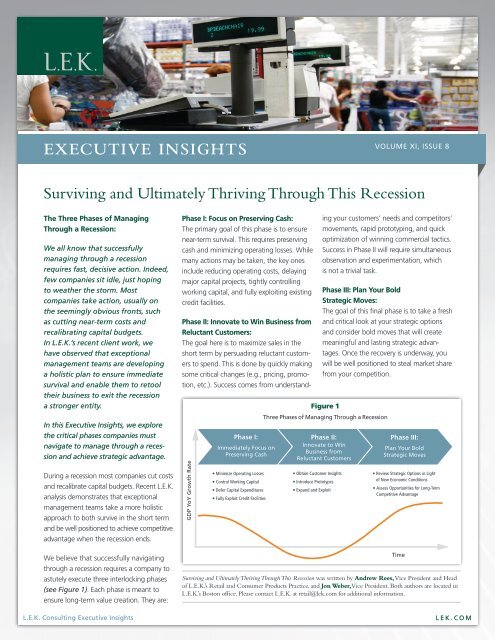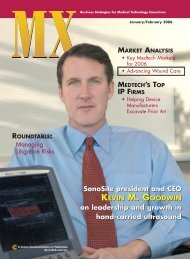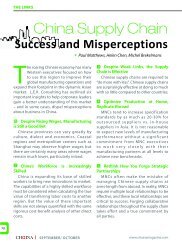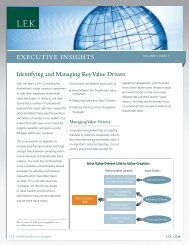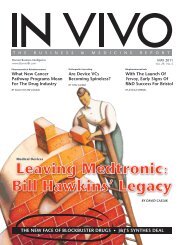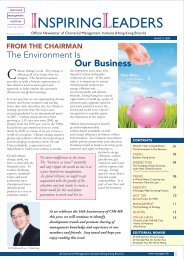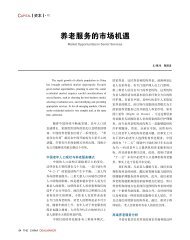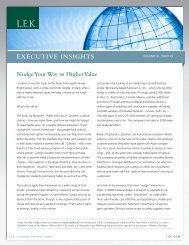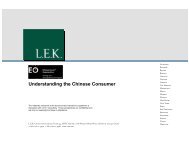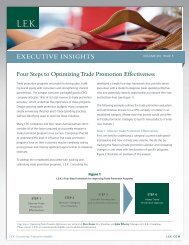EXECUTIVE INSIGHTS - LEK Consulting
EXECUTIVE INSIGHTS - LEK Consulting
EXECUTIVE INSIGHTS - LEK Consulting
Create successful ePaper yourself
Turn your PDF publications into a flip-book with our unique Google optimized e-Paper software.
<strong>EXECUTIVE</strong> <strong>INSIGHTS</strong><br />
L.E.K. <strong>Consulting</strong> Executive Insights<br />
VOLUME XI, ISSUE 8<br />
Surviving and Ultimately Thriving Through This Recession<br />
The Three Phases of Managing<br />
Through a Recession:<br />
We all know that successfully<br />
managing through a recession<br />
requires fast, decisive action. Indeed,<br />
few companies sit idle, just hoping<br />
to weather the storm. Most<br />
companies take action, usually on<br />
the seemingly obvious fronts, such<br />
as cutting near-term costs and<br />
recalibrating capital budgets.<br />
In L.E.K.’s recent client work, we<br />
have observed that exceptional<br />
management teams are developing<br />
a holistic plan to ensure immediate<br />
survival and enable them to retool<br />
their business to exit the recession<br />
a stronger entity.<br />
In this Executive Insights, we explore<br />
the critical phases companies must<br />
navigate to manage through a recession<br />
and achieve strategic advantage.<br />
During a recession most companies cut costs<br />
and recalibrate capital budgets. Recent L.E.K.<br />
analysis demonstrates that exceptional<br />
management teams take a more holistic<br />
approach to both survive in the short term<br />
and be well positioned to achieve competitive<br />
advantage when the recession ends.<br />
We believe that successfully navigating<br />
through a recession requires a company to<br />
astutely execute three interlocking phases<br />
(see Figure 1). Each phase is meant to<br />
ensure long-term value creation. They are:<br />
Phase I: Focus on Preserving Cash:<br />
The primary goal of this phase is to ensure<br />
near-term survival. This requires preserving<br />
cash and minimizing operating losses. While<br />
many actions may be taken, the key ones<br />
include reducing operating costs, delaying<br />
major capital projects, tightly controlling<br />
working capital, and fully exploiting existing<br />
credit facilities.<br />
Phase II: Innovate to Win Business from<br />
Reluctant Customers:<br />
The goal here is to maximize sales in the<br />
short term by persuading reluctant customers<br />
to spend. This is done by quickly making<br />
some critical changes (e.g., pricing, promotion,<br />
etc.). Success comes from understand-<br />
GDP YoY Growth Rate<br />
Phase I:<br />
Immediately Focus on<br />
Preserving Cash<br />
• Minimize Operating Losses<br />
• Control Working Capital<br />
• Defer Capital Expenditures<br />
• Fully Exploit Credit Facilities<br />
Surviving and Ultimately Thriving Through This Recession was written by Andrew Rees, Vice President and Head<br />
of L.E.K.’s Retail and Consumer Products Practice, and Jon Weber,Vice President. Both authors are located in<br />
L.E.K.’s Boston office. Please contact L.E.K. at retail@lek.com for additional information.<br />
Figure 2<br />
Guerrilla Innovation SM Framework<br />
Phase II:<br />
Innovate to Win<br />
Business from<br />
Reluctant Customers<br />
• Obtain Customer Insights<br />
• Introduce Prototypes<br />
• Expand and Exploit<br />
ing your customers’ needs and competitors’<br />
movements, rapid prototyping, and quick<br />
optimization of winning commercial tactics.<br />
Success in Phase II will require simultaneous<br />
observation and experimentation, which<br />
is not a trivial task.<br />
Phase III: Plan Your Bold<br />
Strategic Moves:<br />
The goal of this final phase is to take a fresh<br />
and critical look at your strategic options<br />
and consider bold moves that will create<br />
meaningful and lasting strategic advantages.<br />
Once the recovery is underway, you<br />
will be well positioned to steal market share<br />
from your competition.<br />
Figure 1<br />
Three Phases of Managing Through a Recession<br />
Phase III:<br />
Plan Your Bold<br />
Strategic Moves<br />
• Review Strategic Options in Light<br />
of New Economic Conditions<br />
• Assess Opportunities for Long-Term<br />
Competitive Advantage<br />
Time<br />
L E K . C O M
Phase I: Focus on<br />
Preserving Cash<br />
During a recession, companies will typically<br />
experience a series of hits to their financial<br />
position: revenues decline rapidly, profits<br />
evaporate, inventories balloon and receiv-<br />
ables expand. The net result is a dramatic<br />
reduction in cash flow and a commen-<br />
surate depletion of cash reserves. During<br />
this first phase, companies must act<br />
rapidly and decisively to preserve cash.<br />
Cash will ensure survival as well as<br />
provide the ability to outperform and<br />
outmaneuver competitors. It will become<br />
an immediate source of competitive<br />
advantage during the recession. There<br />
are five priorities during Phase I:<br />
• Priority One is inventory. For most<br />
retailers, the greatest and most<br />
immediate source of financial pressure is<br />
unsold inventory. Converting inventory<br />
back into cash is critical for funding<br />
payment of near-term operating costs,<br />
as well as buying new merchandise for<br />
the upcoming season. Remember you<br />
will be fighting against aggressive<br />
competition for your customers’ wallets.<br />
This requires action on two fronts:<br />
– Liquidating current excess inventory<br />
and taking early and decisive mark-<br />
downs;<br />
– Recalibrating future sales expecta-<br />
tions, reducing open-to-buy for future<br />
seasons, and negotiating with ven-<br />
dors to reduce and/or cancel orders<br />
already in the supply chain.<br />
• Priority Two is operating expenses.<br />
Effectively reducing expenses first<br />
requires a realistic expectation of future<br />
Page 2 L.E.K. <strong>Consulting</strong> Executive Insights Vol. XI, Issue 8<br />
revenues. Operating expenses should<br />
be cut to levels that ensure the busi-<br />
ness earns a minimum return. These<br />
reductions ideally take place only once<br />
and are carefully coordinated and com-<br />
municated. For most retailers there are<br />
three primary drivers of expense, all<br />
of which should be considered in any<br />
cost-cutting program:<br />
– Stores: The number of stores you oper-<br />
ate drives significant expense through-<br />
out your organization. Although not<br />
traditionally viewed as the first place to<br />
cut costs, pruning the store portfolio<br />
will yield substantive savings.<br />
– SKUs: Eliminating low-volume and low-<br />
margin SKUs will help by both manag-<br />
ing inventory levels and eliminating<br />
extraneous selling expenses.<br />
– People: SKU rationalization and store<br />
closures will already start to reduce<br />
headcount. In addition, look closely at<br />
functions that might not be as busy in<br />
the future, like store construction and<br />
IT. And examine the layers of your<br />
organization and reconsider their<br />
respective spans of control.<br />
• Priority Three is capital expenditures.<br />
It is important to cancel or delay major<br />
capital expenditure projects that do not<br />
put the business in immediate jeopardy<br />
or do not have a very short (i.e.,12–18<br />
months) cash payback time frame.<br />
This would typically include major<br />
IT upgrades, new store openings and<br />
new distribution centers.<br />
• Priority Four is accounts payable. If<br />
possible, take advantage of payment<br />
terms (e.g., pay early to get a discount).<br />
<strong>EXECUTIVE</strong> <strong>INSIGHTS</strong><br />
Work with vendors to extend payment<br />
terms if necessary, but do so without<br />
impairing relationships or access to<br />
future goods and services.<br />
• Priority Five is to fully exploit your<br />
credit facilities. If you entered the<br />
recession with attractive credit facili-<br />
ties, this will likely become a source of<br />
strategic advantage.<br />
It goes without saying that time is of the<br />
essence in Phase I. We believe that strong<br />
management teams should be able to<br />
develop and execute a cash preservation<br />
strategy within four to six weeks. While<br />
many of these priorities may seem obvi-<br />
ous, implementing a comprehensive cost-<br />
cutting plan is not trivial. We have found<br />
that companies either tend to focus only<br />
on low-hanging fruit leaving significant<br />
opportunities for savings on the table,<br />
or fail to monitor the performance of<br />
cost-cutting measures against expecta-<br />
tions. Given the severity of this reces-<br />
sion, it may be necessary to implement<br />
incremental cost-cutting measures in the<br />
future as circumstances warrant. Flexibility<br />
and continued vigilance around your cost<br />
structure are essential.<br />
Phase II: Innovate to<br />
Win Business from<br />
Reluctant Customers<br />
During a recession customers’ require-<br />
ments change: they buy less, they may<br />
want different products or services, they<br />
increasingly look for greater values, and<br />
they respond to different marketing<br />
stimuli. Your challenge as a consumer-<br />
based business is to adjust your near-term<br />
commercial tactics to maximize revenue<br />
opportunities and profits.<br />
L E K . C O M
We believe companies can strengthen<br />
their performance during a recession. We<br />
call this approach Guerrilla Innovation.<br />
It employs a cascade of iterative engage-<br />
ments with customers to identify and test<br />
multiple tactics that can realign existing<br />
products and services to stimulate<br />
near-term spending.<br />
While the needs of your customers have<br />
changed, you cannot wait until your<br />
traditional innovation process identifies<br />
new products to meet those needs.<br />
Guerrilla Innovation’s focus still taps<br />
into the heart of what drives solid innova-<br />
tion strategy: customer engagement.<br />
But instead of applying it to developing<br />
new ideas, products and services, the<br />
immediate goal is tactical adaptations<br />
of existing offerings through three sets<br />
of activities (see Figure 2).<br />
1. Obtain Customer Insights:<br />
The first step in adjusting to your<br />
customers’ evolving needs is gaining<br />
information. Because customer insights<br />
must be captured and acted upon<br />
in real time, it is important to move<br />
beyond traditional customer research<br />
methods (e.g., customer surveys, store<br />
intercepts, focus groups) and leverage<br />
faster, more interactive techniques such<br />
as customer panels, online forums and<br />
shop-alongs.<br />
In addition, greater attention must be<br />
paid to any nuances in shopping behavior<br />
metrics (e.g., average transaction size,<br />
product mix, website behavior) as these<br />
may also be immediate sources of valu-<br />
able insights which should be rapidly<br />
distributed across your organization.<br />
Page 3 L.E.K. <strong>Consulting</strong> Executive Insights Vol. XI, Issue 8<br />
2. Introduce Prototypes:<br />
Rapid or “micro” prototyping involves<br />
introducing many ideas at once and<br />
letting the market decide the win-<br />
ners and losers. The key to achieving<br />
quick validation of ideas is having a<br />
strong testing program that can deliver<br />
insights in a controlled and limited-risk<br />
environment.<br />
Introduce<br />
Prototypes<br />
Introducing many prototypes at once is<br />
risky, but you can mitigate this risk by<br />
limiting the test to a small sample. Start<br />
by developing a plan to introduce pro-<br />
totypes in select locations or for select<br />
Figure 2<br />
Guerrilla Innovation SM Framework<br />
Step One<br />
Internal Capability Assessment<br />
and Sources of Value<br />
Obtain<br />
Customer<br />
Insights<br />
<strong>EXECUTIVE</strong> <strong>INSIGHTS</strong><br />
customers. Then streamline your testing<br />
plan to ensure timely response and data<br />
collection, leveraging channels that Figure will 3<br />
Sample elicit Framework a more immediate for Surviving response and (e.g., Ultimately Thriving<br />
web sales). As part of your plan, assign<br />
metrics to gauge success (e.g., store<br />
traffic, Situation transactions, Assessment basket size) and<br />
weigh the performance of each idea<br />
accordingly.<br />
Step Two<br />
Expand<br />
and<br />
Exploit<br />
The universe of options in Phase II<br />
Customer Behavior<br />
Analysis<br />
Step Three<br />
Deep Competitive<br />
Evaluation<br />
may be limited, so do not abandon<br />
a prototype without understanding<br />
why it failed. Consider modifying the<br />
prototype before discarding it.<br />
We find that the best management teams<br />
look for opportunities even in the worst<br />
of times. The bold moves they make position<br />
their companies to be the winners in the<br />
post-recession marketplace.<br />
Step Four<br />
Market and Value<br />
Chain Evolution<br />
L E K . C O M
3. Expand and Exploit:<br />
Once you have identified the most<br />
promising tactics for attracting custom-<br />
er spending, these opportunities need<br />
to be immediately rolled out to relevant<br />
locations and customers.<br />
Central to proper execution is identify-<br />
ing appropriate processes to manage<br />
promising projects. Progress must<br />
be measured consistently and tactics<br />
refined based on customer feedback.<br />
With market conditions changing so<br />
rapidly, a winning idea can turn into<br />
a loser if not rolled out quickly and<br />
monitored continually.<br />
Organizing for Guerrilla Innovation<br />
requires immediate and tight coordina-<br />
tion between multiple stores, marketing<br />
vehicles and functions of your business.<br />
You may lack the resources or expertise<br />
to do this, so consider allocating a dedi-<br />
cated command-and-control team.<br />
This team will oversee customer insight<br />
management, the testing program<br />
and evaluation of results. Centralizing<br />
this effort will not only ensure rapid<br />
responses to any market fluctuations<br />
but also keep your marketing, sales and<br />
operations teams working efficiently<br />
and in concert.<br />
Once underway you will find that<br />
Guerrilla Innovation typically focuses on<br />
changes to pricing, product mix, promo-<br />
tions and/or messaging. You can glean a<br />
number of lessons in each of these areas<br />
from companies that have successfully<br />
demonstrated strong customer engage-<br />
ment and a direct response to their<br />
customers’ evolving needs. For example:<br />
Page 4 L.E.K. <strong>Consulting</strong> Executive Insights Vol. XI, Issue 8<br />
- Pricing: Publicized shifts in product<br />
pricing can change value perception<br />
and drive revenue gains. For example,<br />
Sonic launched its first value menu in<br />
December 2008 in recognition that<br />
value-based options are driving incre-<br />
mental growth in the quick service seg-<br />
ment during this economic downturn.<br />
Traditionally, Sonic has relied on an<br />
array of signature menu items and its<br />
brand strength to drive sales but turned<br />
to strategic pricing to stem the impact<br />
of the recession. Sonic’s “Everyday<br />
Value Menu,” which includes 10 items<br />
priced under one dollar, is increasing<br />
store traffic by providing broader op-<br />
tions for budget-conscious customers.<br />
- Product Mix: Changing product mix to<br />
appeal to shifting consumer needs can<br />
drive sales growth. For example, Family<br />
Dollar has evolved its product portfolio<br />
and shifted its in-store product mix<br />
more heavily toward everyday neces-<br />
sities and consumables (e.g., food,<br />
detergents). The company also invested<br />
in equipment (coolers) to support<br />
increased food and beverage sales.<br />
Consumables now account for over<br />
60% of sales and Family Dollar is reap-<br />
ing the benefits of this change in its<br />
product mix. Walmart recognized that<br />
private label products mark some of the<br />
greatest opportunities in this reces-<br />
sion, as consumers in the food and<br />
beverage category (and beyond) are<br />
showing great interest in trading down.<br />
Walmart has responded by relaunch-<br />
ing its “Great Value” brand to increase<br />
the share of lower-priced private label<br />
offerings in its stores.<br />
<strong>EXECUTIVE</strong> <strong>INSIGHTS</strong><br />
- Promotions: Launching time-sensitive<br />
promotions with perceived value can<br />
increase customer loyalty during the<br />
downturn. Kroger, Food Lion and<br />
Albertsons were quick to offer value-<br />
added promotions for cashing in<br />
economic stimulus checks. In Kroger’s<br />
case, customers could benefit from a<br />
value increase of 10% for immediate<br />
conversion of the full value of their<br />
checks into Kroger gift cards. The<br />
benefits of this were twofold: Kroger<br />
captured 100% of the value of the<br />
stimulus checks and it strengthened its<br />
perception among consumers as being<br />
a value retailer.<br />
Hyundai offered consumers the ability<br />
to return a purchased car if they lost<br />
their jobs within a year. This promotion<br />
directly addressed the finding that con-<br />
sumers were so worried about making<br />
payments that traditional rebates and<br />
incentives were not stimulating sales.<br />
Hyundai’s success has spurred others<br />
to offer similar promotions.<br />
Dollar General also targeted consumers’<br />
anxiety over the economy by kicking<br />
off 2009 with its “Fresh Start New Year<br />
Sweepstakes.” This promotion, which<br />
did not require purchase for eligibility,<br />
included over $180,000 in cash prizes.<br />
- Messaging: Simple tweaks can make<br />
your marketing messages align more<br />
closely with your customers’ most<br />
immediate concerns. Staples shifted the<br />
message of its iconic “Easy Button”<br />
campaign. When the campaign<br />
launched in 2003, the “Easy Button”<br />
was created to demonstrate ease of<br />
shopping. Amid poor economic<br />
L E K . C O M
GDP YoY Growth Rate<br />
conditions, Staples’ • Control advertisements Working Capital were<br />
repositioned to convey • Defer that Capital shopping Expenditures at<br />
• Fully Exploit Credit Facilities<br />
Staples makes it easy for consumers to<br />
save money, acknowledging the increased<br />
importance to consumers of savings over<br />
convenience.<br />
Phase III: Plan Your<br />
Bold Strategic Moves<br />
Economic downturns have always resulted<br />
in a new set of companies emerging as<br />
leaders. We find that the best manage-<br />
While there is no universal prescription for<br />
ment teams look for opportunities even in<br />
Figure 2 capitalizing on these circumstances, there<br />
the worst of times. The bold moves they<br />
Guerrilla Innovation are five areas that deserve consideration:<br />
make position their companies to be the<br />
SM Framework<br />
winners in the post-recession marketplace.<br />
with a Major Competitor:<br />
Right now the market is Obtain wide open and<br />
If you’re convinced your business is<br />
looks nothing like it did Customer a year ago. Just<br />
focused on the right market opportuni-<br />
look at your competitive Insights landscape: the<br />
ties, your primary goal should be to<br />
weakest players are battling for survival<br />
increase market share and gain scale.<br />
(or perhaps have already lost the battle).<br />
An economic downturn can turn the<br />
Some have pulled out of specific markets<br />
weaker or non-core assets of other<br />
or scaled back their operations in other<br />
companies into potential targets that can<br />
ways. And nearly everyone is operating Expand<br />
immediately deliver on this goal.<br />
very conservatively.<br />
and<br />
Introduce<br />
Exploit<br />
It is not simply enough to acquire<br />
Now look Prototypes at your customers: unlike past<br />
cheap assets (though this could play<br />
downturns, this one is likely to redefine<br />
a role in your broader strategic plan).<br />
their value equation – from where they<br />
You should also look to take advantage<br />
shop, to when and how often, and at<br />
of a transaction that will propel you<br />
Step One<br />
Internal Capability Assessment<br />
and Sources of Value<br />
Phase I:<br />
Immediately Focus on<br />
Preserving Cash<br />
• Minimize Operating Losses<br />
Page 5 L.E.K. <strong>Consulting</strong> Executive Insights Vol. XI, Issue 8<br />
Three Phases of Managing Through a Recession<br />
Phase II:<br />
Innovate to Win<br />
Business from<br />
Reluctant Customers<br />
<strong>EXECUTIVE</strong> <strong>INSIGHTS</strong><br />
• Obtain Customer Insights<br />
• Review Strategic Options in Light<br />
what price • Introduce point. Prototypes<br />
of New Economic Conditions<br />
And finally look at your into a leadership position. Many<br />
distributors • Expand and Exploit<br />
• Assess Opportunities for Long-Term<br />
suppliers: they are more<br />
Competitive companies Advantage have successfully employed<br />
willing than ever to modify or revamp this strategy. For example, consider<br />
their existing business practices and<br />
terms. These changing dynamics, coupled<br />
with the availability of discounted assets,<br />
spell huge opportunities. Strategic<br />
options that you never considered or<br />
were not viable even a year ago may<br />
now be available and could provide<br />
significant competitive advantage. Now<br />
is the time to start planning.<br />
1. Grab Share by Buying/Merging<br />
Figure 3<br />
Phase III:<br />
Plan Your Bold<br />
Strategic Moves<br />
TJX’s acquisition of Marshalls over a<br />
decade ago. In 1995, Melville Corporation<br />
considered Marshalls one of its lowest<br />
performers after several quarters of<br />
declining operating profits. TJX was<br />
Time able to acquire Marshalls for $550 mil-<br />
lion, an attractive price for a business<br />
with $2.8 billion in sales at that time.<br />
The acquisition immediately trans-<br />
formed TJX into the clear market leader<br />
and in two years its share price more<br />
than doubled, creating $2 billion in<br />
shareholder value.<br />
2. Diversify by Buying into<br />
Adjacent Sectors:<br />
As you plan your bold strategic moves,<br />
take a close look at your value chain.<br />
You may find that the lines between<br />
segments have blurred, that some<br />
adjacencies have been more resilient to<br />
the downturn than others, or that you<br />
have the unique ability to extract more<br />
value by extending beyond your current<br />
domain. Diversifying within the value<br />
chain may provide top-line growth, pro-<br />
tection against future downturns, and<br />
incremental value for your customers.<br />
Sample Framework for Surviving and Ultimately Thriving Through This Recession<br />
Situation Assessment Strategic Road Map<br />
Step Two Step Three<br />
Step Four<br />
Step Five<br />
Step Six<br />
Customer Behavior<br />
Analysis<br />
Deep Competitive<br />
Evaluation<br />
Market and Value<br />
Chain Evolution<br />
Strategic Options<br />
Identification<br />
Strategic Options Evaluation<br />
and Prioritization<br />
L E K . C O M
CVS’s acquisition of Caremark is a prime<br />
example. Combining CVS, the largest U.S.<br />
retail pharmacy chain, and Caremark, one<br />
of the top pharmacy benefits managers,<br />
was not an obvious play at the time and<br />
indeed some still have their doubts. The<br />
two entities compete in prescriptions<br />
fulfillment. However, CVS saw a significant<br />
opportunity in combining pharmacy<br />
benefits management capabilities with<br />
its large retail distribution network.<br />
After battling hostile counter-bids from<br />
rival pharmacy benefits company Express<br />
Scripts, Inc., CVS ultimately prevailed in<br />
combining the two entities. This bold<br />
strategic move has undoubtedly been a<br />
game changer for CVS, transforming it<br />
into a comprehensive pharmacy services<br />
organization whose reach spans employers,<br />
health plan providers, and consumers. The<br />
combined company is now the country’s<br />
largest buyer and distributor of prescription<br />
drugs, providing it much greater leverage<br />
with drugmakers. More broadly though,<br />
CVS/Caremark has its eyes set on lever-<br />
aging the two companies’ capabilities,<br />
including a massive prescription database<br />
to improve patient compliance.<br />
3. Expand into New<br />
Geographical Markets:<br />
Virtually every market in the world is<br />
being redefined by the global nature of<br />
this downturn. Global as well as region-<br />
al players have experienced a weaken-<br />
ing of their dominance in the markets<br />
they serve. Now is the time to recon-<br />
sider your existing global footprint and<br />
determine which geographies are good<br />
prospects for gaining market share.<br />
This expansion into new geographical<br />
markets is different from placing bets<br />
Page 6 L.E.K. <strong>Consulting</strong> Executive Insights Vol. XI, Issue 8<br />
on emerging markets where your<br />
company’s growth will be highly<br />
correlated with GDP. Instead it involves<br />
identifying and exploiting pockets of<br />
unmet customer demand in mature<br />
markets which, if successful, could<br />
be hugely profitable.<br />
Take the German discount grocery<br />
chain ALDI. It is seizing on the disrup-<br />
tion created by the economic downturn<br />
to ratchet up its expansion into the U.S.<br />
ALDI is launching an aggressive strategy<br />
to enter mature markets and steal share<br />
from Walmart, other discount stores<br />
and traditional grocers. Many of its 75<br />
new store openings in 2009 will be<br />
in the heart of Walmart territory, with<br />
prices between 15% and 20% lower<br />
than Walmart. ALDI is able to price so<br />
low because nearly 95% of goods sold<br />
in its stores are private label. ALDI’s vast<br />
and global purchasing power allows<br />
it to secure contracts with suppliers<br />
at a lower cost than its competitors.<br />
While grocery chains across the U.S. are<br />
seeing higher sales from private label<br />
products, most are only stocking them<br />
at 20% to 30% levels.<br />
Furthermore, as ALDI expands into<br />
the U.S., it is also refining its offerings<br />
to better meet the needs of its target<br />
consumers based on valuable learn-<br />
ings from ALDI’s current stores. With a<br />
business model perfectly suited to the<br />
economic environment, ALDI is in a<br />
prime position to steal market share.<br />
4. Dramatically Re-engineer the<br />
Supply Chain to Systemically<br />
Reduce Risk:<br />
Many strategic options focus on<br />
external growth (e.g., new markets,<br />
<strong>EXECUTIVE</strong> <strong>INSIGHTS</strong><br />
new products and services), but bold<br />
strategic moves can also be focused in-<br />
ternally to make your existing business<br />
more nimble and profitable. You will<br />
need to retool your business model to<br />
reduce exposure to risks inherent in the<br />
current business.<br />
Spanish retailer Zara has systematically<br />
reduced its fashion risk by bringing<br />
virtually every function across the value<br />
chain, from design to manufacturing,<br />
in-house. By creating a more efficient<br />
value chain, Zara is now capable of tak-<br />
ing a design from concept to shelf within<br />
two weeks. No retailer can beat that.<br />
Zara’s model of quick inventory turn-<br />
around mitigates one of the greatest<br />
risks for any retailer: unsold inventory.<br />
The reasons for this are two-fold. First,<br />
designers can build out a line after seeing<br />
which fashions have already succeeded<br />
in the market. And second, no line is ever<br />
produced in significant quantity. This<br />
has made Zara one of the most flexible<br />
and dynamic retailers in the world.<br />
5. Enhance Your Channels of Distribution:<br />
As you gain a greater understanding of<br />
your customers, you will find that your<br />
current customers no longer purchase the<br />
same way and in the same places. Fur-<br />
thermore, the market has redefined which<br />
customer segments are the most attractive<br />
and you must now gain access to them.<br />
There are many ways to broaden your<br />
distribution to reach different customers.<br />
For Gap Inc., it has meant looking to its<br />
online division (Gap Inc. Direct) to create<br />
opportunities beyond simply making the<br />
product in its stores available to consum-<br />
ers online. Gap Inc. Direct has built an<br />
L E K . C O M
online-only brand, Piperlime, to sell brand-<br />
ed footwear and accessories. It has also<br />
acquired the women’s activewear company<br />
Athleta with the intention of dramati-<br />
cally growing this nascent brand through<br />
exposure to its large volume of online traf-<br />
fic. In short, Gap Inc. Direct is establishing<br />
a growth strategy independent of Gap’s<br />
physical stores.<br />
For most management teams, being able<br />
to objectively assess how their business, its<br />
competitive position and the marketplace<br />
have changed due to the recession can<br />
be challenging and require substantial<br />
resources. There are no short cuts. We<br />
believe that every business needs to under-<br />
L.E.K. <strong>Consulting</strong> is a global management<br />
consulting firm that uses deep industry<br />
expertise and analytical rigor to help clients<br />
solve their most critical business problems.<br />
Founded more than 25 years ago, L.E.K.<br />
employs more than 900 professionals in<br />
20 offices across Europe, the Americas and<br />
Asia-Pacific. L.E.K. advises and supports<br />
global companies that are leaders in their<br />
industries – including the largest private<br />
and public sector organizations, private<br />
equity firms and emerging entrepreneurial<br />
businesses. L.E.K. helps business leaders<br />
consistently make better decisions, deliver<br />
improved business performance and<br />
create greater shareholder returns.<br />
For more information, go to www.lek.com.<br />
Page 7 L.E.K. <strong>Consulting</strong> Executive Insights Vol. XI, Issue 8<br />
take a thorough situation assessment that<br />
will form the basis of a refreshed market<br />
view and allow the management team to<br />
systematically evaluate and prioritize their<br />
strategic options. We outline a framework<br />
(see Figure 3), that L.E.K. <strong>Consulting</strong> has<br />
used to lead clients through this process.<br />
Conclusion<br />
In this article we have described how the<br />
best companies can survive and ultimately<br />
thrive despite this pernicious recession.<br />
The three phases we have outlined are<br />
all necessary to secure the long-term<br />
strength of your business post-recession,<br />
For further information contact:<br />
Boston<br />
28 State Street<br />
16th Floor<br />
Boston, MA 02109<br />
Telephone: 617.951.9500<br />
Facsimile: 617.951.9392<br />
Chicago<br />
One North Wacker Drive<br />
39th Floor<br />
Chicago, IL 60606<br />
Telephone: 312.913.6400<br />
Facsimile: 312.782.4583<br />
Los Angeles<br />
1100 Glendon Avenue<br />
21st Floor<br />
Los Angeles, CA 90024<br />
Telephone: 310.209.9800<br />
Facsimile: 310.209.9125<br />
New York<br />
650 Fifth Avenue<br />
25th Floor<br />
New York, NY 10019<br />
Telephone: 212.582.2499<br />
Facsimile: 212.582.8505<br />
San Francisco<br />
100 Pine Street<br />
Suite 2000<br />
San Francisco, CA 94111<br />
Telephone: 415.676.5500<br />
Facsimile: 415.627.9071<br />
<strong>EXECUTIVE</strong> <strong>INSIGHTS</strong><br />
and require both short-term focus and<br />
long-term planning. Phases I and II are<br />
focused on the near term: preserving<br />
cash and persuading reluctant custom-<br />
ers to spend. In Phase III, the focus is<br />
the future, taking a hard look at the<br />
macro factors at play to develop in-<br />
novative and game-changing strategic<br />
moves. Each phase has its own distinct<br />
objectives and benefits, and compa-<br />
nies that successfully execute on them<br />
are poised to be the winners in the<br />
post-recession marketplace.<br />
International<br />
Offices:<br />
Auckland<br />
Bangkok<br />
Beijing<br />
London<br />
Melbourne<br />
Milan<br />
Mumbai<br />
Munich<br />
New Delhi<br />
Paris<br />
Shanghai<br />
Singapore<br />
Sydney<br />
Tokyo<br />
Wroclaw<br />
L E K . C O M


